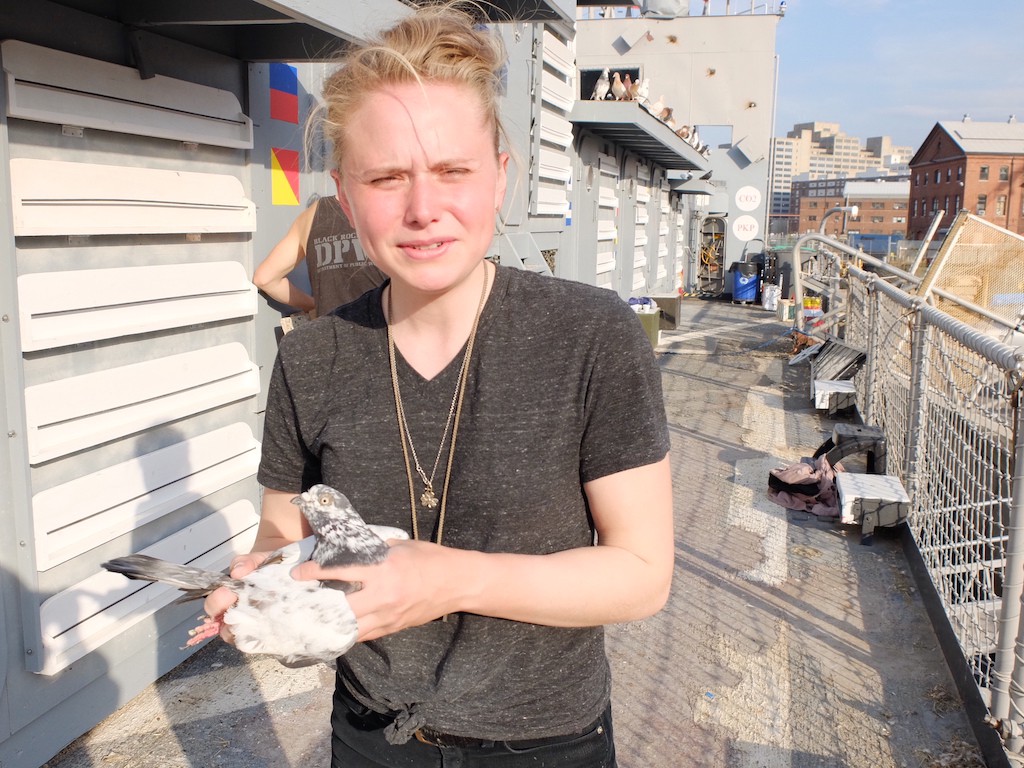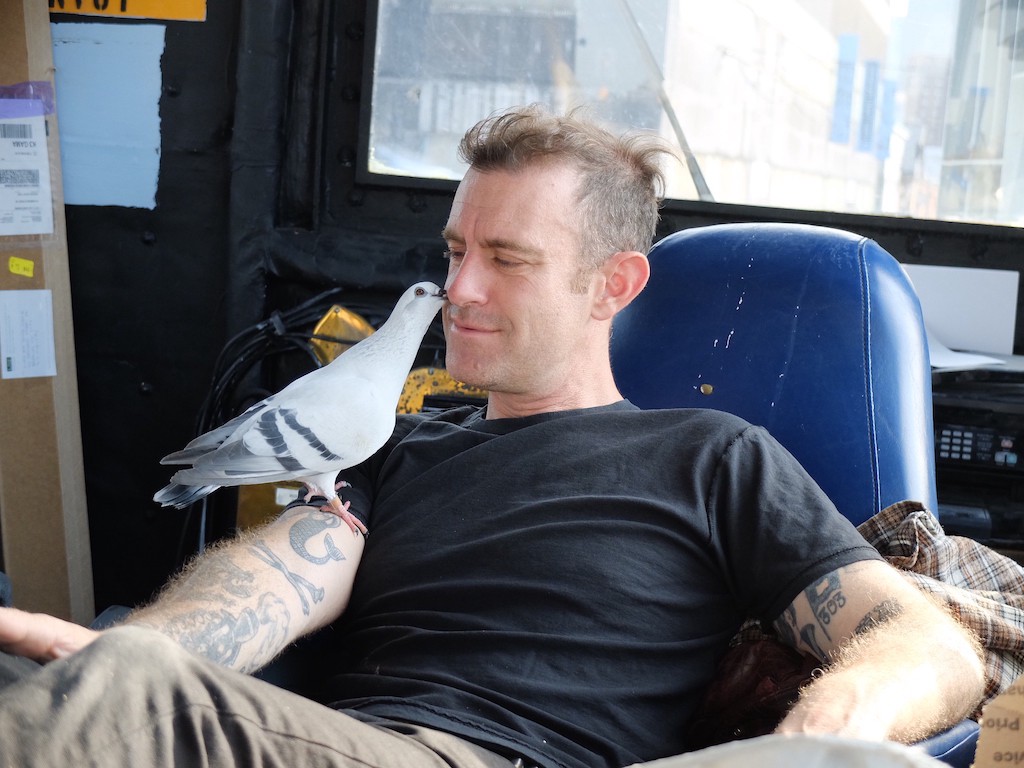The Woman Behind The Illuminated Pigeons
by Rebecca McCarthy

An otherwise angelic looking blond girl, Madeline Joyce was covered in pigeon shit. We were sitting in Feeney’s, a strange bar on the ass-end of Sunset Park, where the big news was its potential sale to an elusive man named George. George promised to bring new life to the place — overhaul it completely, advertise, and change the name. “Guess what he wants to call it,” she said. “What would you name your bar if you were trying to appeal to young people, but you didn’t really understand the internet?”
Grumpy Cat. George wanted to name the bar Grumpy Cat, but no one could figure out how he planned to get around copyright law, and when I checked online I could find no pending liquor licenses for the address. Feeney’s looks more like an aggressively Irish gas station than it does a bar, but Joyce is oddly attached to it. “My favorite gas station,” she said.
Joyce works for Duke Riley, a Brooklyn-based artist whose exhibitions often resemble elaborate, historical pranks. In 2007, for “After the Battle of Brooklyn,” Riley constructed a replica of the submarine that attempted to attack a British flagship during the Revolutionary War. He launched his sub in the East River and snuck up on the Queen Mary II, managing to get pretty close before Harbor Patrol picked him up. “SUB-MORON,” cried the cover of the New York Post the next morning. In 2013, he trained pigeons to smuggle cigars from Havana to Key West for a project called “Trading with the Enemy.” They were outfitted with small harnesses to carry video cameras, one of which was briefly mistaken for a bomb when the pigeon landed on a boat. His current project is sponsored by Creative Time, a non-profit known for fleeting, site-specific installations, like Kara Walker’s “A Subtlety” and Paul Chan’s “Waiting for Godot in New Orleans.” It’s called “Fly by Night,” and it comprises two thousand pigeons with L.E.D. lights attached to their ankles swooping over the Brooklyn Navy Yard.

Joyce grew up in Westfield, New Jersey, in the kind of family that attended Knights of Columbus fundraisers and refuses to drink Coors because “it’s Nazi beer.” She graduated from Pratt in 2011 with a degree in Illustration. She was chosen out of about three hundred applicants to work with Riley through a listing she found on the job board for the New York Foundation for the Arts. “She was tougher than anyone else,” Riley told me. “I needed somebody that was both intelligent and talented but also…” he trails off. We sat in the pilot house of the Baylander, a decommissioned, Vietnam-era battleship that now houses the pigeon coops. A Syrian Damascene flew in and perched on his knee. “Scrappy?” I said. “Scrappy, and uh…not squeamish,” Riley said.
Riley has raised pigeons for much of his life, since his childhood in Boston, but prior to “Trading with the Enemy” he hadn’t kept a coop in several years due to the chaotic nature of his schedule. He began building up a small flock again in early 2012. “I’m traveling a lot of the time so it really became a lot of Maddy’s responsibility,” he says. “Which I guess at first I was nervous about, because I felt like it wasn’t necessarily part of her original job description, but you know, as with most things, Maddy never really seemed to complain about it.” Joyce remembered it a little differently. “Duke and I were in a taco shop and Duke turned to me and was like, ‘Maddy, how do you feel about ten thousand pigeons?’” She was ambivalent, but as the coop grew, she fell in love with them. “Generally, that’s what happens when you start messin’ around with pigeons,” Riley said. “They kinda creep up on you.”

Pigeon keepers are weirdos, almost without exception. It’s a labor-intensive, solitary hobby, the origins of which stretch back thousands of years. “I think there’s two main categories,” said Riley. “The ones that have absolutely nothing to say at all and are total recluses and the ones that are recluses most of the time, until you get them talking about pigeons and then they won’t shut the fuck up. And some of them are a little shady, you know, myself included probably.” Every pigeon on this continent was originally brought here as a domesticated bird — either for food or companionship or for their service as couriers — and despite the multitude of breeds you see today, they’re all descended from the Rock Dove, Columba livia.
In addition to the Syrian Damascenes, the “Fly by Night” pigeons includes Homers, Rollers, Tumblers, Flights, and Russian Highfliers. “So many ridiculous names for these birds,” Joyce said. They’ve been worshiped as symbols of peace and fertility, coveted by everyone from the French aristocracy to the Italian mob, fought in wars. In 2010, a pigeon beat out a broadband connection in rural England. It’s an impressive track record for animals that are generally regarded as malingerers at best and vermin at worst. Colin Jerolmack, author of The Global Pigeon and an Associate Professor at NYU, sifted through 155 years of New York Times articles for his 2008 paper “How Pigeons Became Rats: The Cultural-Spatial Logic of Problem Animals.” He believes our changing attitude towards the pigeon says far more about us than it does the bird. “Rhetorically framing pigeons as rats with wings,” he wrote, “reveals a cultural anxiety about disorder and a deeply felt need for a sanitized city that goes beyond a concern for diseases pigeons may harbor.”
According to one estimate, there are only about 100 pigeon keepers left in New York City, most of them in Bushwick and Sunset Park. They’re a diverse, close-knit bunch, but while pigeon-keeping has managed to transcend race and class, it rarely breaks the gender divide. “The pigeon community is made up of…men,” Joyce says. “Only men, one hundred percent. They’re obsessed. This is their life. I mean I’ve met a lot of them — it’s like being in seventh grade and talking to boys.”
“I know that there’s a woman in Staten Island about the same age as Maddy, I’ve heard about her, but I’ve never met her,” Riley says. “There used to be a woman in Manhattan that had a huge pigeon coop, but she ended up getting rid of all her birds a few years ago. Other than that, I would say in the United States it’s highly uncommon.” The fact that Joyce is an anomaly doesn’t seem to faze her. “For some reason, all the pigeons that I really fall in love with are like, deformed in some sad way,” she says. “Creative Time asked us to put together all of these pigeons that they want to do bios of and every single one of them that I pulled out they’re like, ‘We can’t even take that picture. People are gonna think we’re mistreating the birds.’”
Johnny Rotten is a tiny, yellow Tiplet with a Mohawk and a deformed leg who, according to Joyce, is “molting all the time for some reason. They only molt for like, a week, but Johnny Rotten’s been molting for like, six months.” Tofu, a Damascene, has become sort of a mascot for “Fly by Night.” Joyce raised him under a heat lamp in her own apartment after he was abandoned by his mother. “Tofu, yeah. Tofu the fuckin’ celebrity,” she said, rolling her eyes. “He lives in the pilot house and nibbles at everyone’s ears and like, is not even a bird at this point, he’s just a human. He has such an enormous ego.” The favorite is Wild Irish Rose, a Homer mixed with an Egyptian Swift, who’s straight out of a Mo Willems book. Training a homing pigeon happens in stages — you release them progressively farther away from the coop so they slowly get the lay of the land. Some thrive and become racing pigeons, others not so much. Wild Irish Rose has a defective wing, so when all the other pigeons flew away she was left to trudge home by herself. “A diligent, little bird, whom I love,” said Joyce.

Joyce is not unlike the birds she cares for. Easily startled, she comes off shy, but she has a dark sense of humor. We got to talking about confirmation names at the bar; hers is Lucy. “The reason I chose St. Lucy,” she said, grinning, “is because she pulls her fucking eyes out.” According to one version of the story, St. Lucy wanted to become a nun, so when a persistent admirer told her he loved her eyes, she gouged them out and gave her dowry away to the poor. Offended, the man had her killed.
It’s this cheerfully grim appreciation for history that drew Joyce to working for Riley in the first place — Riley’s art is legitimately funny without being glib. There’s always a weight behind his work, but it doesn’t take itself too seriously. “It appeals to people who don’t give two shits about art, whatsoever,” Joyce said. “People on the fringe. Like, for instance, the pigeon community. The people I’ve met from this project I don’t think have ever stepped into an art gallery in their lives. And they don’t care to, but it doesn’t mean that they don’t appreciate beautiful things. Duke has a way of making art accessible to people who generally do not seek it out at all.”
“Fly by Night” is uncharacteristically sincere for Riley. There’s no wink and nudge at the end, no ambiguous legality — just birds and their flight patterns. Anyone who’s been in New York for half an hour has seen a pigeon fly, but if you’ve ever really watched them en masse you know it’s breathtaking. Two summers ago, in the early mornings, I got into the habit of sneaking onto the roof of a bar I used to work at. A guy in the building across the street had a coop, so I’d sit there eating breakfast and watching the pigeons as the sun came up over the city and the early-morning drinkers milled about, smoking downstairs. It was beautiful, but it doesn’t compare to “Fly by Night” in terms of scale.
When I went down to the Baylander as a volunteer, Joyce and Riley were on the roof of the coops, waving garbage bags attached to long, bamboo poles, while people on the deck circled them, whooping to get the birds up into the air. It looked more like some sort of strange, religious ritual than it did an art installation. “When you have this bird that comes when you signal it and whatnot,” Riley says. “That can go out and fly over the whole entire city and experience it from this entirely different vantage point and altitude — circle the entire island of Manhattan in minutes and then come back to you — [that] can be a very empowering feeling.”
“I was terrified of flying them,” Joyce said. “You know, like the idea that they would just go up and come back, I thought that was a myth. So to actually let ’em out and they come back every single night it’s…there’s something really weird about it. I think [it] kind of speaks to the human spirit, letting something go that you love and care for so deeply. There’s that single, solitary moment when you’re like ‘Well, fuck. Fuck it.’ And then it comes back. Or it doesn’t come back. That’s kind of the weird beauty of having pigeons. To let the birds go.”
“Fly by Night” runs weekends through June 12th. It’s free and tickets can be reserved online.
